Input interpretation

carbon (chemical element) | palladium (chemical element) | cerium (chemical element)
Periodic table location
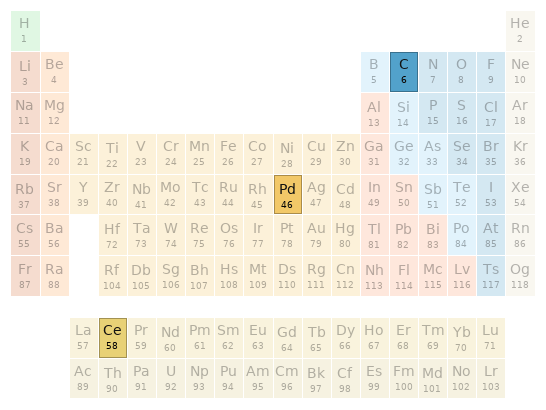
Periodic table location
Images
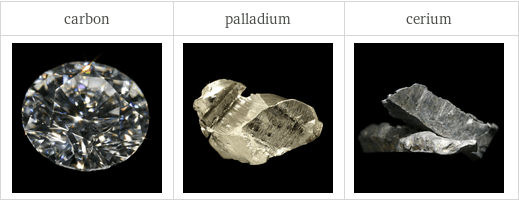
Images
Basic elemental properties
![| carbon | palladium | cerium atomic symbol | C | Pd | Ce atomic number | 6 | 46 | 58 short electronic configuration | [He]2s^22p^2 | [Kr]4d^10 | [Xe]6s^24f^15d^1 Aufbau diagram | 2p 2s | 4d | 5d 4f 6s block | p | d | f group | 14 | 10 | period | 2 | 5 | 6 atomic mass | 12.011 u | 106.42 u | 140.116 u half-life | (stable) | (stable) | (stable)](../image_source/e1047c6224732ab15320961fce4c4a13.png)
| carbon | palladium | cerium atomic symbol | C | Pd | Ce atomic number | 6 | 46 | 58 short electronic configuration | [He]2s^22p^2 | [Kr]4d^10 | [Xe]6s^24f^15d^1 Aufbau diagram | 2p 2s | 4d | 5d 4f 6s block | p | d | f group | 14 | 10 | period | 2 | 5 | 6 atomic mass | 12.011 u | 106.42 u | 140.116 u half-life | (stable) | (stable) | (stable)
Thermodynamic properties
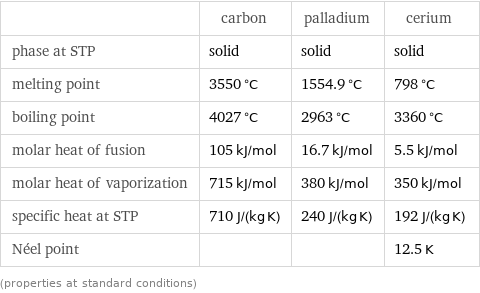
| carbon | palladium | cerium phase at STP | solid | solid | solid melting point | 3550 °C | 1554.9 °C | 798 °C boiling point | 4027 °C | 2963 °C | 3360 °C molar heat of fusion | 105 kJ/mol | 16.7 kJ/mol | 5.5 kJ/mol molar heat of vaporization | 715 kJ/mol | 380 kJ/mol | 350 kJ/mol specific heat at STP | 710 J/(kg K) | 240 J/(kg K) | 192 J/(kg K) Néel point | | | 12.5 K (properties at standard conditions)
Material properties
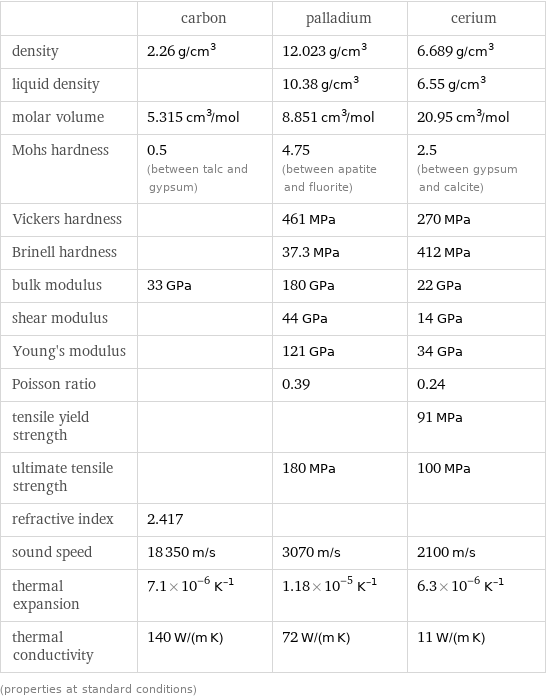
| carbon | palladium | cerium density | 2.26 g/cm^3 | 12.023 g/cm^3 | 6.689 g/cm^3 liquid density | | 10.38 g/cm^3 | 6.55 g/cm^3 molar volume | 5.315 cm^3/mol | 8.851 cm^3/mol | 20.95 cm^3/mol Mohs hardness | 0.5 (between talc and gypsum) | 4.75 (between apatite and fluorite) | 2.5 (between gypsum and calcite) Vickers hardness | | 461 MPa | 270 MPa Brinell hardness | | 37.3 MPa | 412 MPa bulk modulus | 33 GPa | 180 GPa | 22 GPa shear modulus | | 44 GPa | 14 GPa Young's modulus | | 121 GPa | 34 GPa Poisson ratio | | 0.39 | 0.24 tensile yield strength | | | 91 MPa ultimate tensile strength | | 180 MPa | 100 MPa refractive index | 2.417 | | sound speed | 18350 m/s | 3070 m/s | 2100 m/s thermal expansion | 7.1×10^-6 K^(-1) | 1.18×10^-5 K^(-1) | 6.3×10^-6 K^(-1) thermal conductivity | 140 W/(m K) | 72 W/(m K) | 11 W/(m K) (properties at standard conditions)
Electromagnetic properties

| carbon | palladium | cerium electrical type | conductor | conductor | conductor resistivity | 1×10^-5 Ω m (ohm meters) | 1×10^-7 Ω m (ohm meters) | 7.4×10^-7 Ω m (ohm meters) electrical conductivity | 100000 S/m (siemens per meter) | 1×10^7 S/m (siemens per meter) | 1.4×10^6 S/m (siemens per meter) magnetic type | diamagnetic | paramagnetic | paramagnetic volume magnetic susceptibility | -1.4×10^-5 | 7.899×10^-4 | 0.0014716 mass magnetic susceptibility | -6.2×10^-9 m^3/kg (cubic meters per kilogram) | 6.57×10^-8 m^3/kg (cubic meters per kilogram) | 2.2×10^-7 m^3/kg (cubic meters per kilogram) molar magnetic susceptibility | -7.45×10^-11 m^3/mol (cubic meters per mole) | 6.992×10^-9 m^3/mol (cubic meters per mole) | 3.0826×10^-8 m^3/mol (cubic meters per mole) Néel point | | | 12.5 K (kelvins) work function | 5 eV (Polycrystalline) | (5.22 to 5.6) eV | 2.9 eV (Polycrystalline) threshold frequency | 1.209×10^15 Hz (hertz) | (1.262×10^15 to 1.354×10^15) Hz (hertz) | 7.012×10^14 Hz (hertz) superconducting point | | | 0.022 K (kelvins) color | (black) | (silver) | (silver) refractive index | 2.417 | |
Reactivity
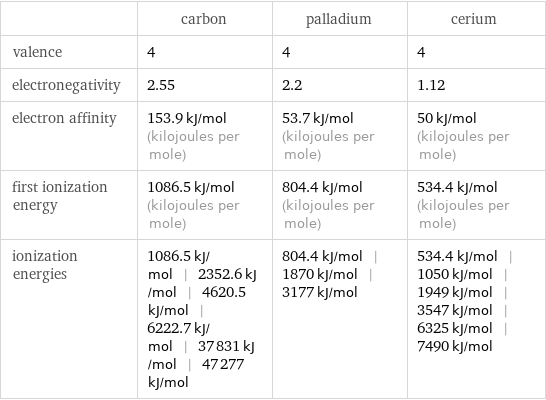
| carbon | palladium | cerium valence | 4 | 4 | 4 electronegativity | 2.55 | 2.2 | 1.12 electron affinity | 153.9 kJ/mol (kilojoules per mole) | 53.7 kJ/mol (kilojoules per mole) | 50 kJ/mol (kilojoules per mole) first ionization energy | 1086.5 kJ/mol (kilojoules per mole) | 804.4 kJ/mol (kilojoules per mole) | 534.4 kJ/mol (kilojoules per mole) ionization energies | 1086.5 kJ/mol | 2352.6 kJ/mol | 4620.5 kJ/mol | 6222.7 kJ/mol | 37831 kJ/mol | 47277 kJ/mol | 804.4 kJ/mol | 1870 kJ/mol | 3177 kJ/mol | 534.4 kJ/mol | 1050 kJ/mol | 1949 kJ/mol | 3547 kJ/mol | 6325 kJ/mol | 7490 kJ/mol
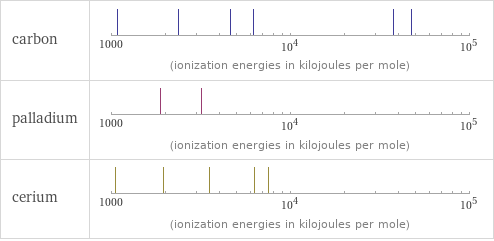
Reactivity
Atomic properties
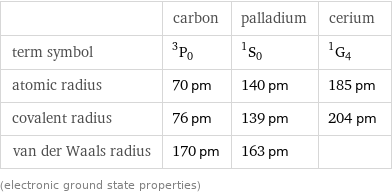
| carbon | palladium | cerium term symbol | ^3P_0 | ^1S_0 | ^1G_4 atomic radius | 70 pm | 140 pm | 185 pm covalent radius | 76 pm | 139 pm | 204 pm van der Waals radius | 170 pm | 163 pm | (electronic ground state properties)
Abundances

| carbon | palladium | cerium universe abundance | 0.5 mass% | 2×10^-7 mass% | 1×10^-6 mass% solar abundance | 0.3 mass% | 3×10^-7 mass% | 4×10^-7 mass% meteorite abundance | 1.5 mass% | 6.6×10^-5 mass% | 7.5×10^-5 mass% crust abundance | 0.18 mass% | 6.3×10^-7 mass% | 0.006 mass% ocean abundance | 0.0028 mass% | | 1.2×10^-10 mass% human abundance | 23 mass% | | universe molar abundance | 0.05 mol% | 2×10^-9 mol% | 9×10^-9 mol% solar molar abundance | 0.03 mol% | 4×10^-9 mol% | 3×10^-9 mol% meteorite molar abundance | 1.8 mol% | 1.3×10^-5 mol% | 1.1×10^-5 mol% ocean molar abundance | 0.0014 mol% | | 5.3×10^-12 mol% crust molar abundance | 0.31 mol% | 9.9×10^-8 mol% | 8.9×10^-4 mol% human molar abundance | 12 mol% | |